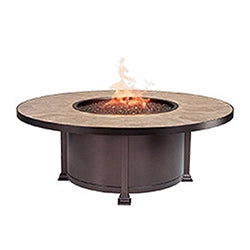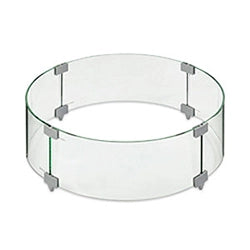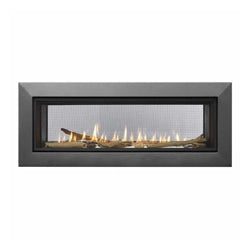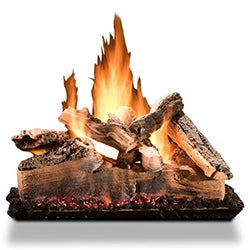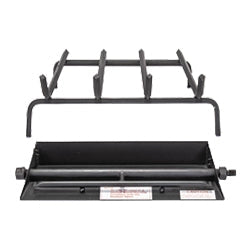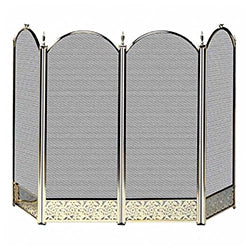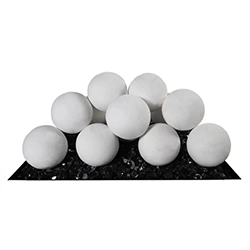In the fire feature industry, you will often hear the term "BTU" thrown around as it relates to heat output. But what does it mean? BTU stands for "British Thermal Units". This term has been around for centuries--and it is still used to this day as the standard for measuring how much heat is generated by a source. It can be used to describe the heat produced by a natural gas fireplace, an electric heater, or a propane fire pit--to name a few. So, what exactly is a BTU and what should you be looking for in terms of heat output for your fire feature? We will answer these questions and more in this handy BTU guide.
What is a BTU?
 Tabletop Fire Pit with Built-in Sound System provides 40k BTUs of heat.
Tabletop Fire Pit with Built-in Sound System provides 40k BTUs of heat.
A British Thermal Unit (BTU) is defined as the thermal energy (heat) required to raise or lower the temperature of one pound of water by one-degree Fahrenheit at sea level. So--technically--BTUs can describe both heating and cooling elements, although the more prevalent usage is for heat output. For the majority of heating elements--fueled by propane, natural gas, electricity, or ethanol--you will find BTU output to be numbered in the thousands. Essentially, the higher the number, the more warmth you will feel from your feature. We find that around 1 BTU has the heat of a single candle, so an everyday 1500-watt floor heater provides around 5k BTUs of comfortable heat, a portable patio heater provides 40k BTUs, and a medium sized fire pit for residential or commercial use is around 90k BTUs on average.
Do BTUs affect flame height?
 These orange flames are fueled by gas, and dance across a bed of dazzling fire glass.
These orange flames are fueled by gas, and dance across a bed of dazzling fire glass.
BTUs do affect flame height to a degree. However, some of the other factors that influence flame height are the amount of air mixed with your gas fuel source, the size of your gas orifices and lines, the distance your fire is from your fuel source, the fire media used and the way it’s laid, as well as the gas pressure. Essentially, BTU output is directly proportional to your flame height, but is also affected by other factors. For more details on what you can do to alter those factors, check out this informative article.
How are BTUs and gas pressure related?
 Matches are good for igniting both wood burning fires and match lit gas fires.
Matches are good for igniting both wood burning fires and match lit gas fires.
PSI--pounds per square inch--and water column are both ways of measuring gas pressure that will influence BTU output of your fire feature. The more gas pressure you have going to your fire pit, heater, or fireplace, the more BTUs you’ll enjoy. It’s important to note, however, that the size of your gas orifices and lines, as well as the burner and ignition you use, can limit the amount of PSI your flames get. If your fuel’s PSI is exceptionally high and can provide up to 90k BTUs, but your fire pit burner maxes out at 50k BTUs, you’ll be limited to the 50k BTUs.
BTU Factoid: Manufacturers of fire features do not typically supply water column or PSI information--instead opting to provide BTU ratings.
How many BTUs do I need to heat my space?
 For a small gathering space outdoors, we recommend 40k-150k BTUs of heat.
For a small gathering space outdoors, we recommend 40k-150k BTUs of heat.
Now that you know what a BTU is, you may be wondering how many BTUs you will need to effectively heat your space. For indoor purposes, the answer is pretty cut and dry (we’ll cover that next). However, outdoor applications will have a lot more variables to keep in mind. With an outdoor fire feature, you will need to account for wind chill and quicker heat dissipation. On average, an outdoor fire feature can put out between 30k-100k BTUs depending on size. You will want to consider the size of your space as well as the average climate for your region when deciding on your preferred BTU output. Check out our helpful BTU graphic above to decide how many BTUs you’ll need.
For indoor fire features, such as fireplace hearths or freestanding fireplaces, there are some pretty simple calculations you can do to find out how many BTUs you should be looking for in a fireplace burner. Calculator.net has a wonderfully handy tool to calculate the BTUs needed to raise the temperature of your room--all you need to do is fill in the dimensions of your room along with your desired temperature. Of course, this calculator does not account for heat loss via chimney for vented fireplace burners, so for that you’d want to estimate for a slightly higher desired temperature.
For example: If your room is 20 feet wide by 25 feet long with 10-foot ceilings and normal insulation, and you would like to raise the temperature of your room by 50 degrees Fahrenheit, you will need a fireplace burner with a heat output of 28k BTUs (this calculation does not account for chimney heat loss of a vented burner).
Which fuel is best for BTU output?
 The Asia Fire Pit by Fire Pit Art is available in many sizes for both gas and wood fuels.
The Asia Fire Pit by Fire Pit Art is available in many sizes for both gas and wood fuels.
In your search for the perfect fire feature or heater, you may be wondering what the best type of fuel is to heat your space. The answer really does come down to preference and resources. Each type of fuel will have pros and cons--but when it comes to heat output and BTUs, wood burning fire features are king. Though higher maintenance than gas or bioethanol burners, the hottest burning fuel you will come across in typical fire features is good old-fashioned wood logs. Natural gas and liquid propane tend to be in the same ballpark when it comes to BTUs--they are comparable in terms of heat output and will depend largely on your burner system. Bioethanol fuel, either in liquid or gel form, will typically burn a lot less intensely than gas and wood features--and put out a much lower number of BTUs. Heaters that run on electricity also tend to put out less BTUs than traditional wood or gas fuel, but it will also depend on the wattage (power) of your electric heater.
BTU Factoid: There aren’t many factors that affect the heat output of wood burning fires, just weather-related things such as wind and rain, and the amount of oxygen available.
How do I calculate how many BTUs my fire can provide?
 There are a few essential aspects that influence the maximum BTUs your fire can achieve.
There are a few essential aspects that influence the maximum BTUs your fire can achieve.
If you’re looking to install a new gas fire feature, or upgrade an existing one, knowing what your BTU max is will certainly help you select the right components for your space. There are two key things to consider: your fuel line and your burner.
BTU Factoid: If you're using a standard 20lb LP--liquid propane--tank to fuel your fire, it's important to note that it maxes out at 90k BTUs. So don't expect 150k BTUs of warmth if you're using an LP tank.
When it comes to your fuel line (if it's natural gas or hard-line propane), the most important aspects are the diameter of the line (point 3) and how far your line extends from your fuel source--most commonly your gas meter (point 4). The larger the diameter of your line, the more gas can pass through, and similarly, the shorter the line, the stronger the gas flow will be. By having a large diameter line as well as shortening the distance from your source, you will improve your available gas pressure and therefore your BTUs. If you are adding a new fire feature, we recommend working with your installer on specific requirements. They can help you find out what your existing gas line diameter is, as well as where it runs, and they can provide suggestions on whether to run a new dedicated line, or possibly increase the size of your existing line. We find that it tends to be more affordable to run a new line.
For example: A 30-foot gas line that is ½” in diameter will provide 95k BTUs while a 30-foot gas line with a ¾” diameter will provide 199k BTUs--almost double the heat! Comparatively, a shorter 10-foot gas line that is ¾” in diameter provides 360k BTUs, showcasing how shorter lines provide higher BTUs.
Regarding the burner you use in your fire feature, regulation and sizing is important. Most fire rings and burners--including ours--are unregulated, meaning that the gas that flows into them is equal to the amount being provided by the gas line. So, if your fire ring or burner is sized to handle the same about of PSI as it is provided with (point 1), you will maximize your BTUs. However, when you change the ignition system or add an orifice or regulator (point 2), you will see a decrease in the gas flow, as this limits the amount of gas going into your burner, generally for safety or automation reasons.
For example: Your fuel line may be sized to provide up to 95k BTUs. If the burner you use is sized to provide 50k BTUs, then your fire feature will provide 50k BTUs. You can maximize your BTUs by using a larger burner.
 One BTU is equivalent to the flame of about a single candle.
One BTU is equivalent to the flame of about a single candle.
In short, BTUs are the industry standard for measuring heat output, and the higher the BTU of your fire feature the more warmth you and your guests will be able to enjoy. There are many ways to increase the amount of heat your fire produces, but it’s important to consider the capacity your home or business has so you can install your fire pit or fireplace accordingly.
For any additional questions on this subject—or for expert help on any project—feel free to contact our friendly and knowledgeable staff by filling out this simple form.







